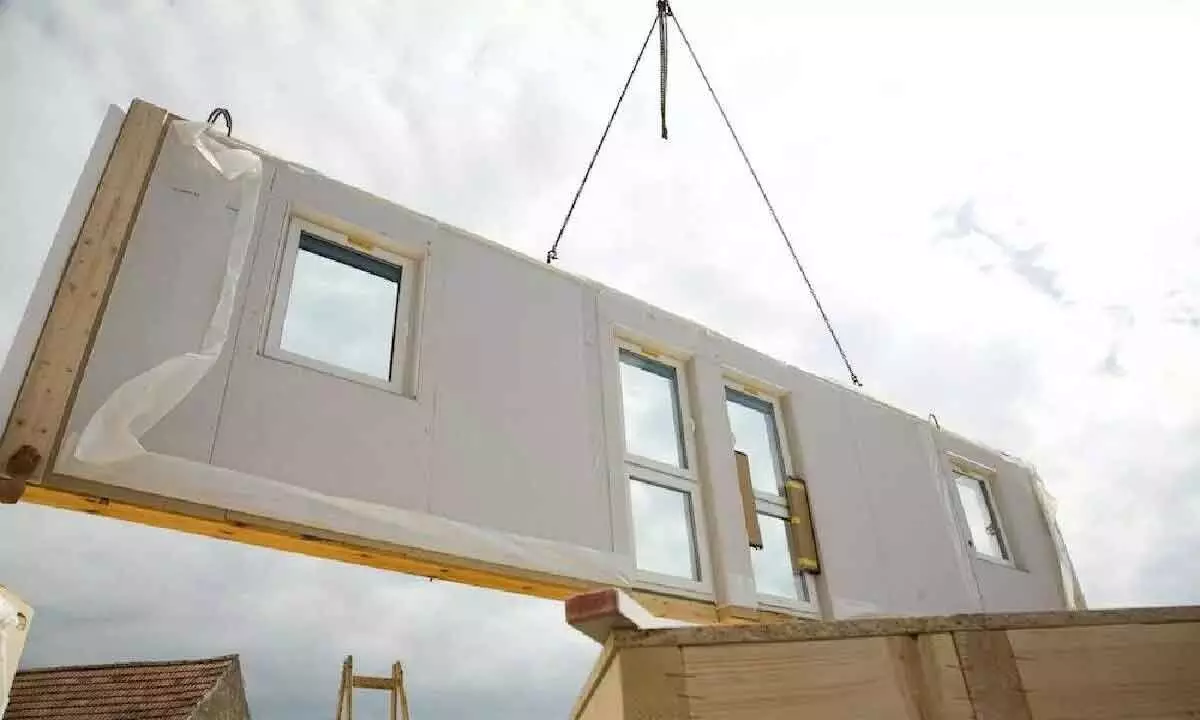Live
- ‘Pushpa-2’ row: Celebs & politicos fail to act fairly
- Learn from fighting spirit of women bravehearts: VHP VP
- BJP MP Arvind, MLA Sanjay Kumar meet CM Revanth
- Rapido partners with L&TMRHL to provide discounted rates
- Kisan Diwas 2024: A Day Dedicated to honor our Farmers.
- Axed ACP takes the wind out of Pushpa hero’s sails
- Tender apology to CM, mantri tells Allu Arjun
- CM condemns attack on Allu Arjun’s house
- Allu Arjun’s house attacked, police arrest 6 persons in city
- APSRTC to replace diesel buses with electric buses
Just In
Prefabricated housing ideal for affordable and concrete solutions


Prospects bright for a massive demand for prefab companies in the future
The size of Prefabricated Housing Market, which stands at $ 19.1 billion in the current year, is anticipated to register a CAGR of over 6% during the forecast period.
The Prefabricated Building Market (PBM) in India is expected to grow at a CAGR of approximately 8.5% during the forecast period, mainly driven nations’ initiatives like “Digital India”, “Smart Cities” etc. The next decade belongs to prefabrication with the country’ construction sector expected to expand to a size of one trillion dollars and contribute over 15% to the overall GDP.
The concept of prefabrication is gaining prominence in the Indian construction market. The entry of prefabricated homes has paved the way to innovative and technologically advanced construction and design methods for all kinds of construction like high rises, low rises, villas, and mass townships.
India is comparatively backward and slow in incorporating prefab constructions into the real estate market.
According to an industrial source, India has only around 1-2% of prefabricated buildings, out of its more than $ 100 billion real estate market. One of the main reasons for the low penetration of prefabrication solutions is a mindset blockade with most developers averse to investing in modular methods of construction and hesitant to incorporate prefabrication in their new and ongoing projects. The size of India’s PBM is $ 2.3 billion in the current year and is anticipated to register a CAGR of over 13% during the forecast period.
India is expected to become the third largest construction market in the world by 2025. The construction sector in the country is expected to expand to a size of $ one trillion, over the next decade, and contribute over 15% to GDP. Given the high anticipated growth of the construction industry, during the forecast period, the prefabricated structures are expected to gain popularity. There is a noticeable uptake of modular techniques with the country’s construction sector slowly transforming and behaving more like the business of manufacturing.
There is a big opportunity for prefab companies here and hundreds of thousands of plants are expected to be required in the future. Over the next few years, India will feature among the fastest-growing countries in terms of construction output, making technology intervention a key component. Prefab construction doesn’t require significant investment for maintenance. While cities like Bengaluru have adopted the concept of prefab, other regions continue to face challenges, owing to issues such as government approvals and a lack of suitable land for construction.
A prefabricated building is a building or part of a building that has been manufactured in advance and can be easily transported and assembled. The Indian prefabricated buildings market is segmented by material type (concrete, glass, metal, timber, and other material types) and by application (residential, commercial, and other applications [industrial, institutional, and infrastructure]).
The country’s construction industry is divided into two categories: real estate and urban development. Residential, office, retail, hotels, and leisure parks are all included in the real estate segment. Water supply, sanitation, urban transportation, schools, and healthcare are all sub-segments of the urban development segment.
By 2025, the urban population will contribute 75% of GDP (up from 63%), and 68 cities will have populations of over one million, up from 42 in 2021. The construction industry is divided into 250 sub-sectors with cross-sectoral connections. By 2030, the real estate industry here is expected to be worth $ one trillion, contributing 13% of the country’s GDP.
India has a $ 1.4 trillion infrastructure investment budget under National Infrastructure Pipeline (NIP), with 24% going to renewable energy, 19% to roads and highways, 16% to urban infrastructure and 13% to railways. Technology-driven urban planning schemes, such as the revolutionary Smart City Mission (target 100 cities), are expected to improve the quality of life. Precast construction, with proper planning and execution, can meet the needs of the housing mark. Precast construction accounts for only two percent of the Indian construction industry’s $ 500 million markets.
Precast systems are mostly used in India for infrastructure projects such as bridges and flyovers. To meet housing demands, the Union Government has approved the use of precast concrete construction methods. According to the Ministry of Housing and Urban Poverty Alleviation, approximately 96% of 18.78 million dwelling units belong to the Economically Weaker Section (EWS) and Low Income Group (LIG) households.

© 2024 Hyderabad Media House Limited/The Hans India. All rights reserved. Powered by hocalwire.com






